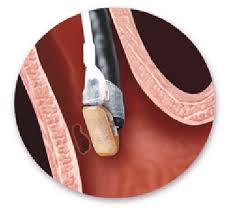What Is Barrett’s Esophagus?
Barrett’s esophagus is a disorder of the esophageal lining that can lead to esophageal cancer. Continuous exposure to stomach acid can cause the cells in the lower esophagus to become damaged, changing the architecture of the cells and increasing an individual’s risk of developing esophageal cancer. Studies have shown that people with Barrett’s disease are 50-80 times more likely to develop esophageal cancer than the general population.
Risk Factors for Developing Barrett’s Esophagus
- Chronic heartburn / acid reflux
- Smoking
- Family history of esophageal cancer
- Gender: Compared with women, men are three times more likely to develop Barrett’s esophagus.
- Age: The risk of getting Barrett’s esophagus increases with age. However, it can occur at any age.
- Race: Caucasians have a higher risk of developing the disease than people of other races.

Risk Factors for Dysplastic Barrett’s Esophagus
- Continued exposure from acid reflux
- Long segment Barrett’s
- Family history of Barrett’s
Symptoms of Barrett’s Esophagus
Many patients with Barrett’s disease demonstrate few, if any, symptoms. However, Barrett’s disease may present with:
- Trouble swallowing food
- Chest pain
- Pain in the upper part of the abdomen
If you are experiencing any of the above symptoms or have risk factors for Barrett’s, you may need to be seen and examined by Dr. Berookim. To determine whether or not you are suffering from Barrett’s esophagus, Dr. Berookim will perform an upper endoscopy to examine the esophageal tissue for signs of change.
Barrett’s Esophagus and GERD
Patients with gastroesophageal reflux disease, or GERD, experience a constant barrage of stomach acid in the lower esophagus, which can predispose them to Barrett’s disease. For this reason, if you’re suffering from chronic heartburn, it’s important to seek treatment to prevent it from developing into a more serious condition like Barrett’s esophagus. In many cases, Dr. Berookim recommends that patients with GERD should be evaluated for Barrett’s disease.
Treatment for Barrett’s Esophagus: Endoscopic Radio-frequency Ablation Therapy
In the past, there were very few treatments available for Barrett’s esophagus. Patients were often told to “wait and see” while doctors monitored their condition. Fortunately, there is a revolutionary therapy available called endoscopic radio-frequency ablation (HALO System), offering new hope to those suffering from Barrett’s disease.
While ablation therapy is not a new procedure, the technology of the HALO system provides improved control and precision to physicians, making it easier to destroy the unhealthy esophageal tissue without injuring the healthy cells in the vicinity.

During The Procedure
During the procedure, Dr. Berookim will utilize the HALO System’s endoscopic radio-frequency ablation therapy to destroy the pre-cancerous esophageal lining. Once the unhealthy tissue has been eliminated, new, healthy tissue can grow back in its place. Performed on an outpatient basis at La Peer Health Systems in Beverly Hills, the procedure takes only 30 minutes. Experts believe that endoscopic radiofrequency ablation therapy can prevent patients from developing a fast-growing form of cancer called esophageal adenocarcinoma.
Contact Dr. Berookim
Because early stages of esophageal cancer can be silent or asymptomatic, it is often diagnosed in the later stages where the survival rate is very low. Thus, it is important to be evaluated early in order to avoid this preventable cancer. If you’re concerned about GERD or Barrett’s Esophagus, please schedule an appointment with Dr. Berookim at The Gastroenterology Institute of Southern California by calling 310-271-1122.



